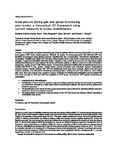Knee posture during gait and global functioning post-stroke: a theoretical ICF framework using current measures in stroke rehabilitation
| dc.contributor.author | Rosa, MCN | |
| dc.contributor.author | Marques, A | |
| dc.contributor.author | Demain, Sara | |
| dc.contributor.author | Metcalf, CD | |
| dc.date.accessioned | 2019-06-06T16:09:23Z | |
| dc.date.available | 2019-06-06T16:09:23Z | |
| dc.date.issued | 2015-05-08 | |
| dc.identifier.issn | 0963-8288 | |
| dc.identifier.issn | 1464-5165 | |
| dc.identifier.uri | http://hdl.handle.net/10026.1/14262 | |
| dc.description.abstract |
PURPOSE: To characterise the global functioning post-stroke in patients with normal knee posture (NKP) and abnormal knee posture (AKP) during loading-response. METHODS: 35 people, 6 months post-stroke. with NKP and AKP were identified and assessed using clinical measures classified into the corresponding International Classification of Functioning, Disability and Health (ICF) domains: weight function (body mass index); muscle power (knee isometric strength); muscle tone (Modified Ashworth Scale); voluntary motor control (Leg sub-score of Fugl-Meyer scale); walking short distances (5-meter walk test; Timed-Up and Go test); walking on different surfaces (Functional Ambulation Categories); moving around (Falls Efficacy Scale); moving using equipment (walking aids) and global assessment of function (WHODAS II). Age, gender, marital status, current occupation and caregivers support characterised personal factors. RESULTS: Patients with AKP had significantly lower knee flexor strength, higher knee flexor and extensor spasticity, more difficulty in maintaining a standing position, walking short and long distances, used walking aids more often and needed more caregiver support. Restriction in activities and participation were correlated with knee flexor strength for AKP and with knee spasticity for NKP group. CONCLUSIONS: AKP restricts functioning and participation. | |
| dc.format.extent | 904-913 | |
| dc.format.medium | Print-Electronic | |
| dc.language | en | |
| dc.language.iso | eng | |
| dc.publisher | Informa UK Limited | |
| dc.subject | Functioning | |
| dc.subject | ICF framework | |
| dc.subject | gait | |
| dc.subject | knee posture | |
| dc.subject | stroke | |
| dc.subject | Aged | |
| dc.subject | Aged, 80 and over | |
| dc.subject | Disability Evaluation | |
| dc.subject | Exercise Therapy | |
| dc.subject | Female | |
| dc.subject | Gait | |
| dc.subject | Humans | |
| dc.subject | International Classification of Functioning, Disability and Health | |
| dc.subject | Knee Joint | |
| dc.subject | Logistic Models | |
| dc.subject | Male | |
| dc.subject | Middle Aged | |
| dc.subject | Muscle Spasticity | |
| dc.subject | Muscle Strength | |
| dc.subject | Postural Balance | |
| dc.subject | Recovery of Function | |
| dc.subject | Stroke Rehabilitation | |
| dc.subject | Walking | |
| dc.title | Knee posture during gait and global functioning post-stroke: a theoretical ICF framework using current measures in stroke rehabilitation | |
| dc.type | journal-article | |
| dc.type | Journal Article | |
| dc.type | Research Support, Non-U.S. Gov't | |
| plymouth.author-url | https://www.ncbi.nlm.nih.gov/pubmed/25095902 | |
| plymouth.issue | 10 | |
| plymouth.volume | 37 | |
| plymouth.publication-status | Published | |
| plymouth.journal | Disability and Rehabilitation | |
| dc.identifier.doi | 10.3109/09638288.2014.948132 | |
| plymouth.organisational-group | /Plymouth | |
| plymouth.organisational-group | /Plymouth/Faculty of Health | |
| plymouth.organisational-group | /Plymouth/Users by role | |
| dc.publisher.place | England | |
| dc.identifier.eissn | 1464-5165 | |
| dc.rights.embargoperiod | Not known | |
| rioxxterms.versionofrecord | 10.3109/09638288.2014.948132 | |
| rioxxterms.licenseref.uri | http://www.rioxx.net/licenses/all-rights-reserved | |
| rioxxterms.type | Journal Article/Review |


